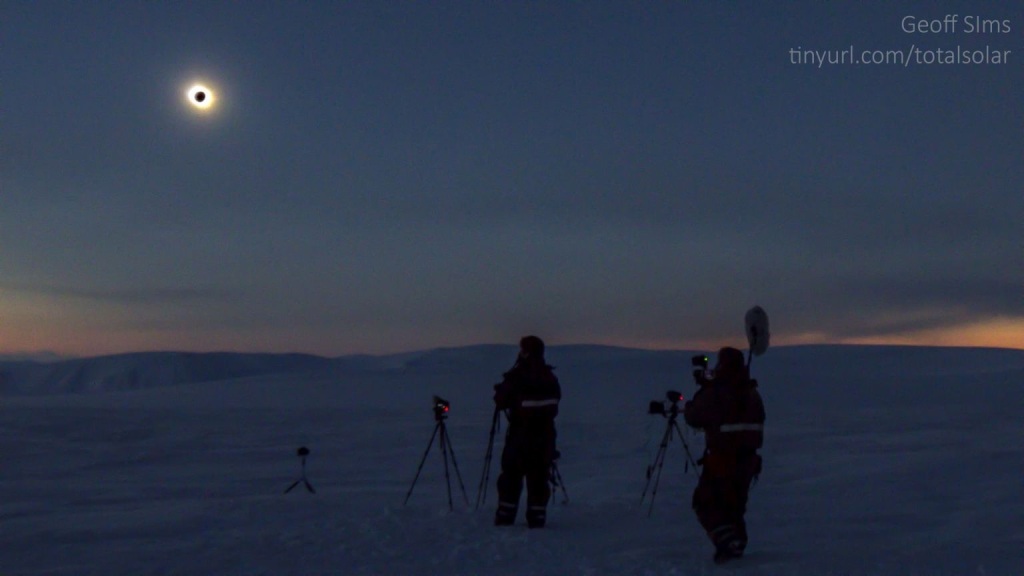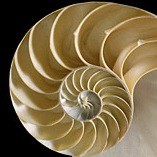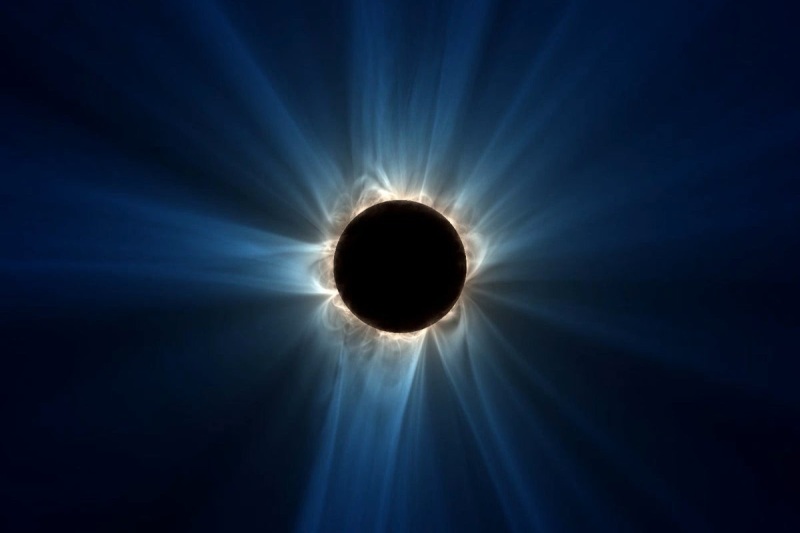The total solar eclipse is one of the most stunning examples of Allah’s precision in creation. After discovering the amazing Metonic cycle, I looked further into the subject of eclipses, which, like the Metonic, also recur in another 19-year cycle, the draconic eclipse cycle. Given the significance of the number 19 in the Quran, I had to look further into this subject, In the Metonic cycle, the moon returns to where it started every 19 years to the day, and the draconic lunar cycle joins them on the same day, despite its different monthly and yearly counts. determined by its intersections with the ecliptic (named for eclipses), which are called nodes. It also connects to the Saros Cycle (explained in this post), which form centuries-long series of cycles used to predict eclipses forward and backward in time. Included in the Antikythera Mechanism, these predictions were done accurately for thousands of years, long before the advancements in knowledge and science we have today. And yes, there are stunning connections between all this and the Quran. So take a deep breath. There’s a lot to learn and it feels necessary to me to include many elements in one post to understand how absolutely stunning this is.
Draconic Cycle Meets Amazing Quranic Ayat/Verses
First, it helps to understand that these cycles are all different aspects of the same one moon’s orbit around the earth as the earth revolves around the sun, giving us a sense of its complexity but also unexpected precision. Here are the numbers (from the site eclipsewitness.com) showing the Metonic cycle including the draconic eclipse cycle. What happens is all three intersect at the same time. These intersections, forming a kind of intricate geometry, are precisely calibrated by the Almighty Creator as shown below. And to what purpose? To bring us a sign in solar and lunar eclipses.
19 Year Draco-Metonic Alignment (same phase of moon and repeating eclipse)
19 solar years ( 365.24 days): 6939.60 days
235 lunar months (29.53 days): 6939.68 days
255 Draconic months (27.21 days): 6939.11 days
This means the solar yearly cycle, the lunar (synodic, phase-based) monthly cycle, and the draconic eclipse cycle (node to node) all meet at exactly 19 years to the day! This kind of precision, which is nothing short of miraculous, means that eclipses occur with striking predictability, both in time and place. To appreciate the significance of this, we need to learn two things: what eclipses are including the cycles that govern them, and the Quranic ayat that relate to them.
As you can see above, the number of days, 6939, is shared by all three cycles, bringing them together in 19 years despite all the irregularities such objects and their orbits/cycles have. So let’s look at the exact reference number in the Quran for this number: 69:39. The reference actually begins in 69:38.
- 69:38 I swear by what you see
- 69:39 And what you do not see
- 69:40 This is the utterance of an honorable messenger.
The number 6939 was rounded off by Meton, for whom the cycle is named, to 6940. And indeed we can see the point of the oath is to impress upon the listener/reader the message of 69:40. It would have been understood that “honorable messenger” meant someone sent directly from Allah/God to people, which the Quran frequently tells us was constantly denied by the people to whom these messengers were sent. So also here, 69:40 affirms this Quran is the truth, a genuine Divine revelation.
As with much of the Quran, these ayat have multiple meanings which elucidate one another. So the ayat above refer to this world which we can see vs. the Unseen/Hereafter which we cannot see. And they can also refer to an eclipse, an event in which we can see the sun, and then the sun is obscured until we cannot see it, and something entirely different appears, the solar corona on a pitch-black disk. To this day it is an awe-inspiring and rare sight, as it also was as long as people inhabited the earth and saw it.
The specific reference 69:39 refers to the part where the sun is eclipsed – becoming what we do not see. And this aya’s reference number is the exact number of days in which that moment is realized, when these irregular, non-mathematically inclined astronomical bodies meet to bring us such an unparalleled event by Allah’s design.
Below is an illustration of the ecliptic to help visualize it, and its importance in astronomy, and below it is a description of the draconic month and its relationship to eclipses; the entire page is incidentally a fascinating look at astronomy, and tells about a 4500 year old tablet that indicates Neolithic people had an exceptional knowledge of astronomy. How little we know about them.
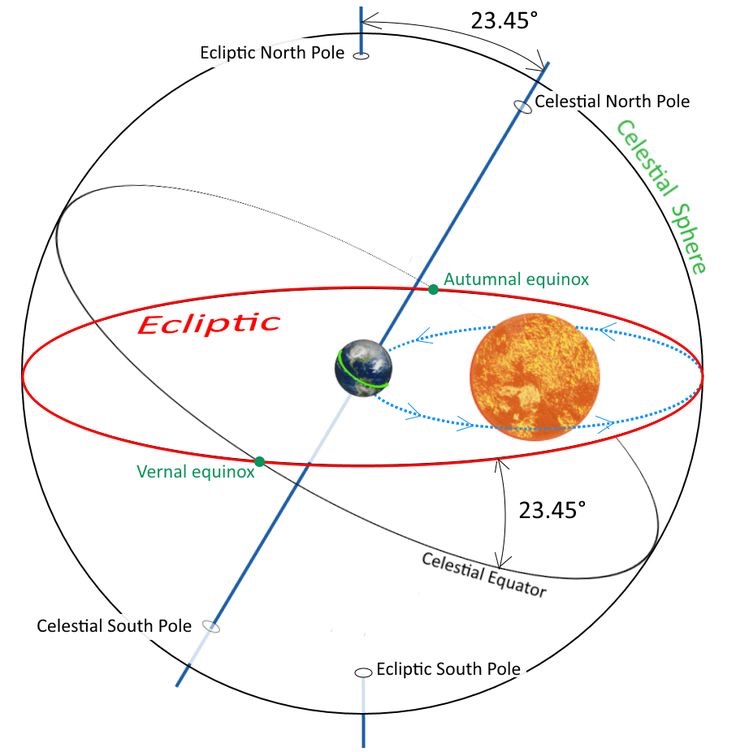
There is also the draconic month (from ancient Greek δράκων (drakon) or Latin draco = dragon), which has a duration of 27.212 days. This duration describes the times at which the lunar orbit, inclined by a good 5 arc degrees to the ecliptic, crosses the ecliptic; the ecliptical latitude of the moon is then exactly zero. These intersection points are called lunar nodes, and they are reached once a month in the ascending lunar node and once a month in the descending lunar node. If the moon is on the ecliptic, i.e. in the proximity of these lunar nodes, a solar eclipse occurs when it is close to the sun (when the new moon is in conjunction with the sun), and a lunar eclipse occurs when it is far from the sun (when the full moon is in opposition to the sun). These points were formerly known as dragon points, which was derived from the idea that a dragon would devour the moon during a lunar eclipse or the sun during a solar eclipse. (The Tal-Qadi Sky Tablet)
I included the part about the dragon devouring the sun or moon in their eclipses because the Arabic word for eclipse, used in Surat Al-Qiyama 75:8 (which we’ll examine here), is khasaf which, with this one exception, is used in the Quran 7 out of 8 times to refer to people or things “swallowed” by the earth.
Ayat Al-Kursi Connection
The draconic cycle’s number of months in relationship to the Metonic cycle is 255. There’s only one aya in the Quran with the number 255, and that’s Ayat Al-Kursi, the most famous aya/verse in the Quran in Surat Al-Baqara (“the Cow” represented in the constellation Taurus) 2:255. So let’s check out my analysis of this aya:
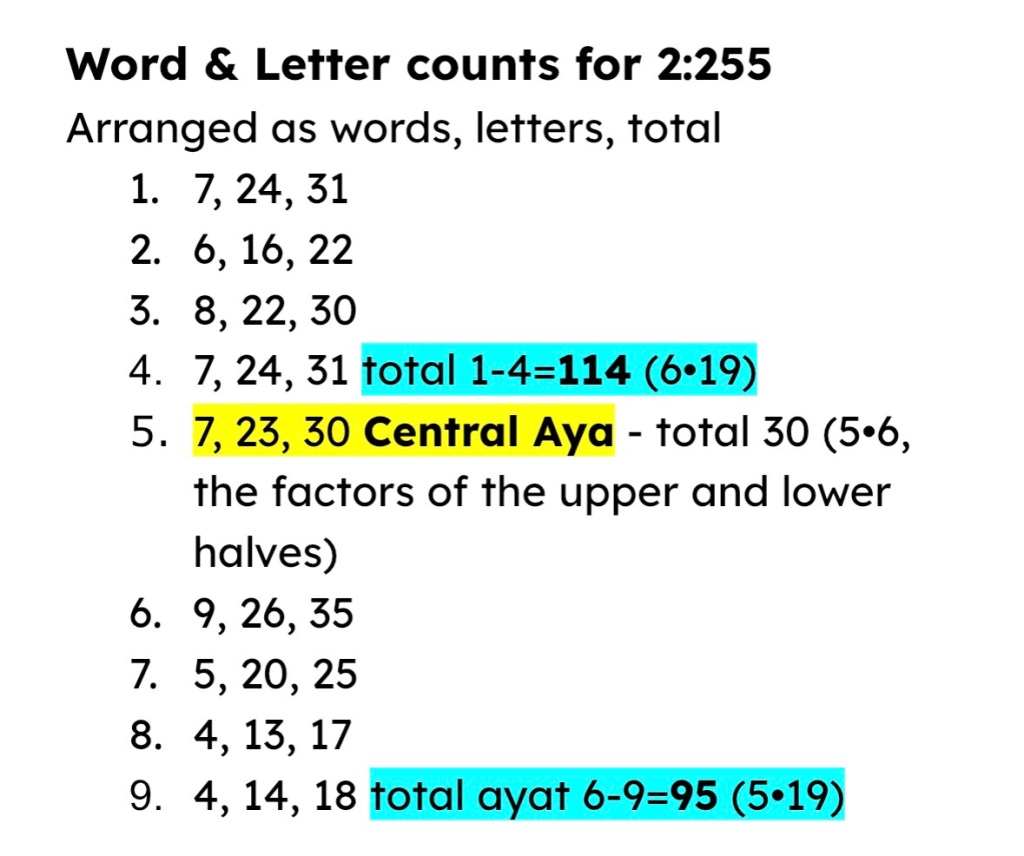
This is a chiastic analysis of the word + letter counts, and as you can see, both the upper and lower sections are multiples of 19, the first a stunning 114, the number of suras in the Quran. Adding these totals together, we get 209 or 11×19. The number 19 is also both the number of solar years in the Metonic cycle, and the number of draconic (eclipse) years in a Saros (the subject of our next section).
The center section of 2:255 has a total of 30 words+letters, whose factors 5 and 6 are also the factors multiplied by 19 in the upper and lower sections, showing amazing integrity within this single aya. If we add 209 + 30, the total is 239, whose connection needs us to understand the Saros Cycle, an important and very different group of cycles that are the key to predicting eclipses. They cover much longer periods of time. All this is a most fitting celestial connection for this aya that beautifully describes Allah’s power and glory.
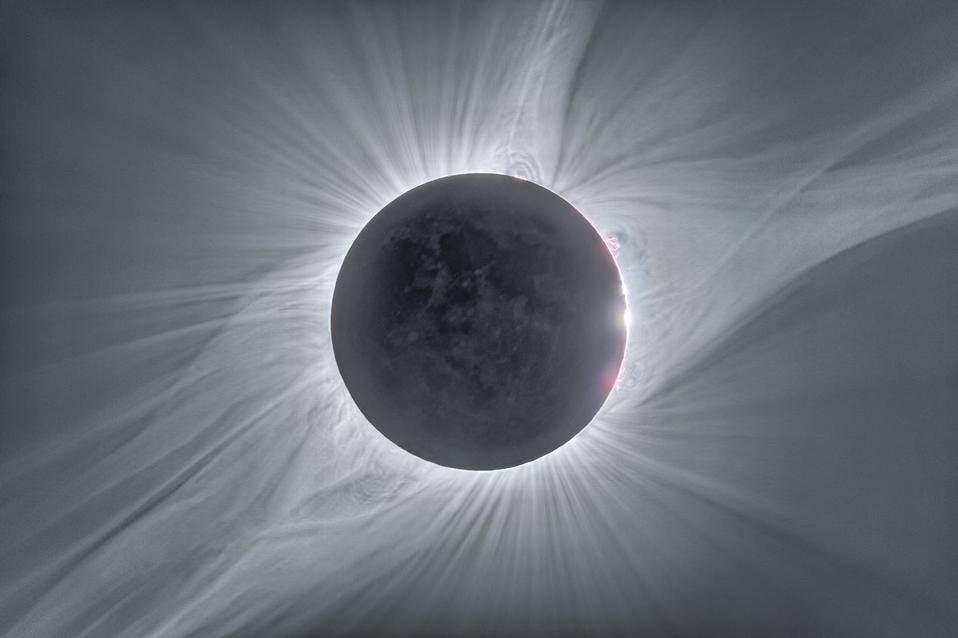
ESO/P. HORÁLEK/SOLAR WIND SHERP
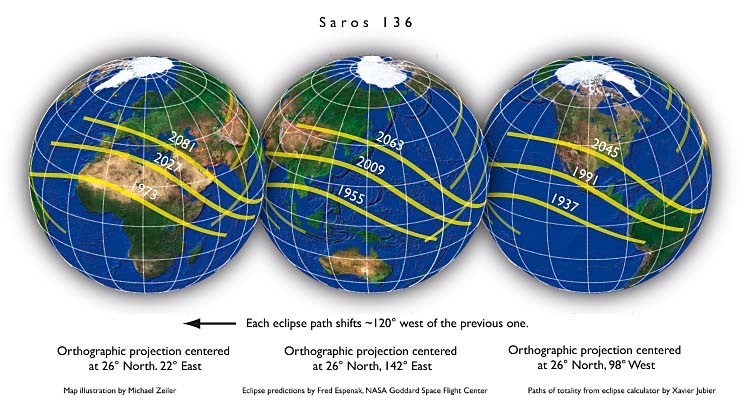
The Saros Cycles
Every Saros Cycle takes exactly 19 Draconic, or eclipse, years. That is 19 x 346.62 – one eclipse year, or the time it takes for the sun, moon and earth return to the same ecliptic node. This amounts to 18 years, 11 days and 8 hours (in solar years). At that time, the Sun, the Earth, and the Moon return to approximately the same relative geometry in relation to the orbits, tilts and nodes of the three celestial objects. One Saros period after a given eclipse, another similar eclipse occurs, displaced by 120 degrees in longitude or one third of the earth. This displacement is due to the remaining eight hours in the duration of the Saros cycle.
Eclipse Witness: Supernatural Patterns and the Cosmic Clock, by Sand Sheff (Hole in the Rock Publishing, 2023)
Note that it takes 242 months for the draconic cycle to complete one Saros, whereas its intersection with the Metonic cycle takes longer, 255 months. And 242 = 2 x 11² and 11 is featured above in the number of days over the 18 solar years for a Saros cycle listed above.
The Saros arises from a natural harmony between three of the Moon’s orbital periods:
NASA eclipse page (includes bullet points below)
- Synodic Month (New Moon to New Moon) = 29.530 days = 29d 12h 44m 03s
- Anomalistic Month (perigee to perigee) = 27.554 days = 27d 13h 18m 33s
- Draconic Month (node to node) = 27.212 days = 27d 05h 05m 36s
One Saros is equal to 223 synodic months, … 239 anomalistic months, and 242 draconic months … equal to within a couple hours!
NASA eclipse page (includes bullet points below)
- 223 Synodic Months = 6585.3223 days = 6585 days 07h 43m
- 239 Anomalistic Months = 6585.5375 days = 6585 days 12h 54m
- 242 Draconic Months = 6585.3575 days = 6585 days 08h 35m
The anomalistic month, shown above as 27.55 days, is often rounded off to 28 (a perfect number) because we live in whole days, not fractions of days. Of the basic lunar cycles, this one is notable in how it influences the type of eclipse that occurs, shown farther below.
Note that the period of the Saros Cycle is 6,585 days, compared to the Metonic cycle’s 6,939 days. The difference between the two is 354 days, considering these whole numbers as approximations. And 354 days is the length of one synodic lunar year! Here’s more about the huge timeframes of the Saros cycle series:
A saros series typically lasts 12 or 13 centuries and contains 70 or more eclipses. Each series begins with about 10 partial eclipses at high latitudes. It slowly evolves to produce to 40 to 50 central eclipses (total, annular, or hybrid). The series eventually ends with about another 10 partial eclipses.
Meanwhile, the anomalistic month is important because the Moon’s distance from Earth (apogee, farthest away, and perigee, closest) determines whether a central eclipse is annular (ring-of-fire eclipse) or total.
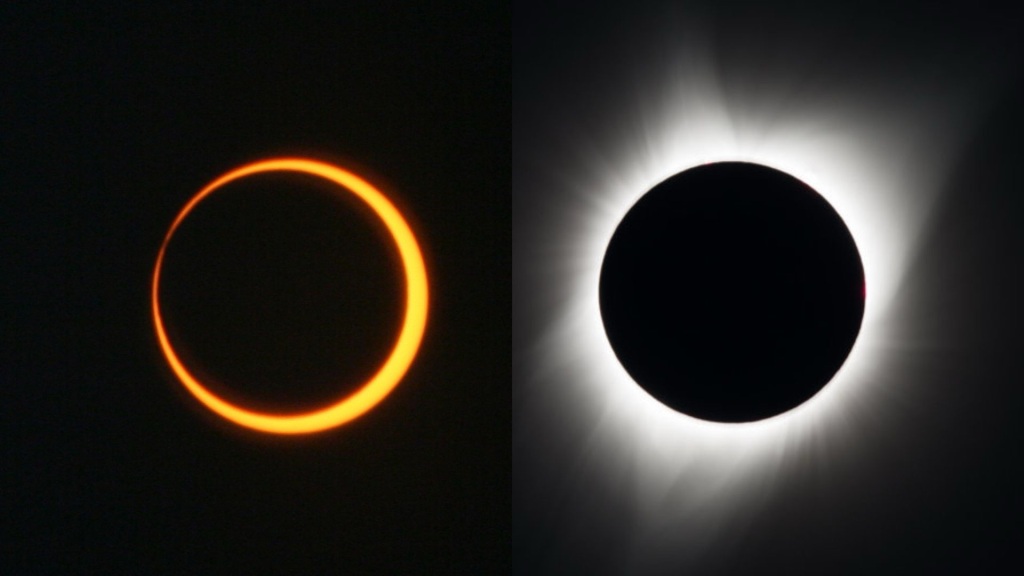
In the long-lasting nature of the Saros series, each series or “character” is given a number, like a name, thus has an “eclipse-spawning life cycle” that is born, starts small with partial eclipses, matures to produce total eclipses, then fades away to partials until it dies.
The Saros Eclipse Cycle creates Saros Characters, or personalities. They are born. They mature. They fade. They die. They have characteristics specific only to them. They exist only because of one of the greatest synchronicities in all of visible existence, the coordination of three separate cosmic calendar alignments.” (Eclipse Witness: Supernatural Patterns and the Cosmic Clock, by Sand Sheff)
It’s important to acknowledge the significance of this phenomenon. In our light-polluted world (who’d have thought light could be a pollution?), all many of us know about the sky is from pictures online, themselves beautiful and amazing, but without any visceral connection to our lives. Something beyond the vapid “we are all stardust” trope. The Quran insha’Allah can help us re-connect to how the heavens and the earth interact and have a direct connection to our lives with their purpose and meaning.
And at the time of prophet Mohammad, the Arabs had a well-developed understanding of the placements of stars, planets, and constellations, and even used them to tell time, as well as guide them on land and sea. There was an appreciation of them, and an extensive cultural view of their significance in our lives we have lost. Yet we see far more closeup spectacular views than they had of nebulae, galaxies, planets, our moon and other moons – without spending a moment learning or thinking about them. So consider the math…
A Saros is also “coincidentally” almost perfectly equal (to within a day) to 239 anomalistic months (27.55 days). The math: 239 x 27.55 equals 6585.45 days. The anomalistic month is the time between perigee to perigee of the moon. It’s when the distance of moon to earth as it orbits returns to about the same. This gives Saros their character, so that they stay consistent (as partial, total or ring of fire) for lengthy periods of time. Over time, they slowly change.
Eclipse Witness: Supernatural Patterns and the Cosmic Clock by Sand Sheff
So a Saros can be said to have 239 anomalistic (apogee-perigee) months.
And this is the numerical connection between the Saros cycle and Ayat Al-Kursi 2:255. All of its words and letters add to 239, the number of anomalistic lunar months in a Saros!
And the aya number 255 is the same as the draconic months in the Metonic cycle, tying together the moon, the sun, and the eclipses of the moon and sun in two different cycles, the Metonic and the Draconic – here in this single (and famous) aya in the Quran.
Thus the Quran literally embeds the data for a saros in its most famous aya speaking of Allah’s power and knowledge.
And just as we found an aya relating to the number 6939 for the Metonic cycle, 69:39, an oath swearing by “what you see and what you do not see” which can describe a solar eclipse, so too we can look for a Quranic aya relating to the Saros cycle in days, 6585.
The Saros is 6585 days:
- Draconic: 19 x 346.62 = 6585.78 days.
- Synodic: 223 x 29.53 = 6585.19 days.
- Anomalistic: 239 x 27.55 = 6585.45 days
So I looked up the number 6585 in the Quran. Sura 65 has only 12 ayat so we turn to sura 6 aya 58 + the 5th word, which is written 6:58:5. As we have discussed in matters relating to sets, such as the {2,3,4} set, numbers in the Quran can be viewed in multiple formulations, such as the mentions of Al-Rahman being 34 and the mentions of raheem being 3⁴. Same digits, different configurations and “values,” connected by a shared pattern.
In fact, the Quran reference 6:58:5 (sura:aya:word) falls on the fifth word mă in bold below, which means “what/that” and refers to Resurrection/ Judgment Day as follows:
قُل لَّوۡ أَنَّ عِندِى مَا تَسۡتَعۡجِلُونَ بِهِۦ لَقُضِىَ ٱلۡأَمۡرُ بَيۡنِى وَبَيۡنَكُمْۗ وَٱللَّهُ أَعۡلَمُ بِٱلظَّٰلِمِينَ
Say, “If I had that for which you are impatient, the matter would have been decided between me and you, but Allah is most knowing of the oppressors.” (Al-An’am 6:58:5)
This is in response to prophet Mohammad’s people challenging him to bring on Resurrection/Judgment Day to prove what he says is true, so the word “that” here refers to Resurrection/ Judgment Day. Thus the aya reference here connects the Saros with Judgment Day or the Hereafter: “that (referring to Judgment Day) for which you are impatient.”
The Aya matches exactly a word that refers to Judgment Day as a “time” prophet Mohammad does not have. Of course not, because the prophet is in dunya time, but Judgment Day is an entirely different timeframe we can’t possibly know. Because to know it is to be in it – a state from which we can’t go back to this world and its timeframe. I call the akhira (Hereafter) timeframe “timelessness” because it doesn’t have time the way we know it, but I don’t and can’t actually know exactly what that is or means. And neither can anyone else. This is entirely and solely the domain of Allah, the Almighty Allah-Merciful.
Which is why only the word that is highlighted here.
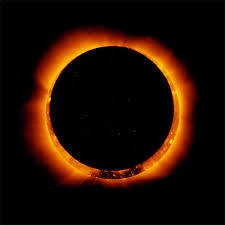
41:37 Again! This aya keeps coming back
This brings us back to that singular aya whose reference is 41:37 which bears repeating here:
Among His signs are the day and the night, and the sun and the moon. Do not prostrate to the sun or the moon, but prostrate to Allah, Who created them ˹all˺, if you ˹truly˺ worship Him ˹alone˺. (41:37)
The way the sun and moon are mentioned, once in the positive sense and once in the negative sense, “do not worship the sun or the moon,” reminds me of the aya in 69:39 “now it is seen, and now it isn’t.” It opens the possibility 41:37 also has an eclipse connection.
In the meantime, there’s a Quranic sura which not only mentions “eclipse” but also “the sun and the moon are joined.” The excerpt is below
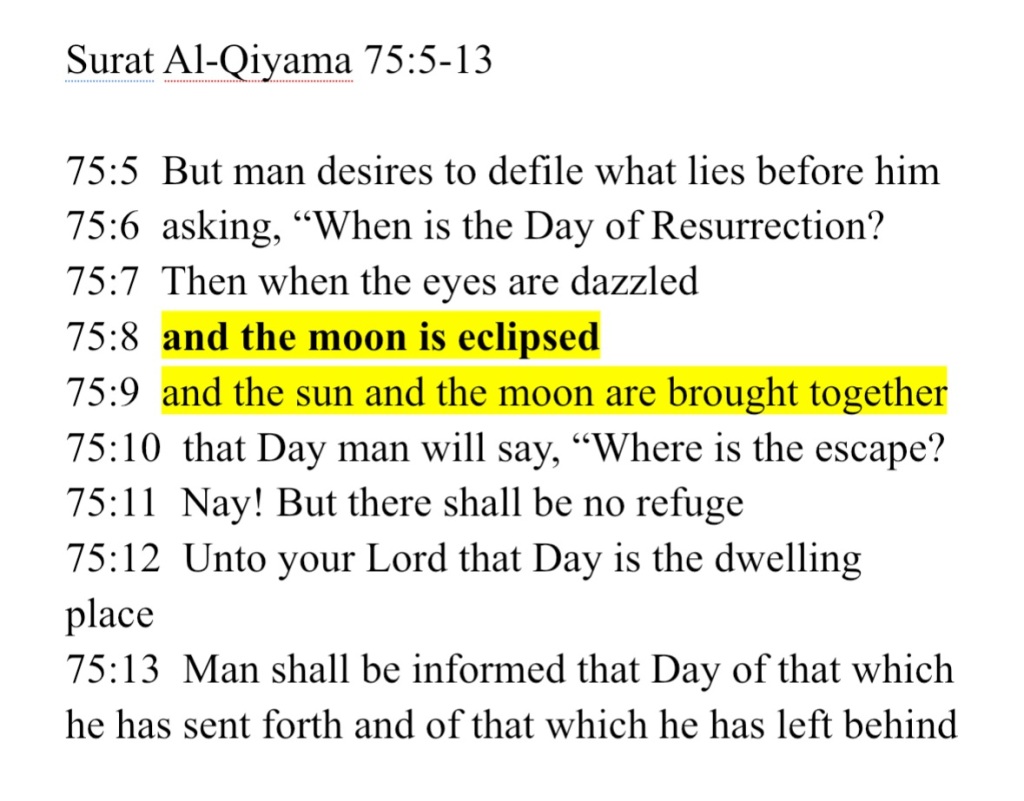
The word translated here “eclipsed” is khasaf which, in every aya in the Quran except this one, is used to mean “swallow,” most commonly “swallowed by the earth.” Similarly, the word “draconic” comes from the idea that a dragon “swallowed” the sun (as mentioned earlier). This word khasaf is the word still used in modern Arabic to mean “eclipse.”
Here, however, it refers to the moon being eclipsed or possibly “darkened,” followed by the sun and moon being “brought together,” “joined,” or even “merged” in various translations. The Arabic is jumi’a with the same root as Jum’a, the word for Friday, coming from the root idea of “gathering together.” So it’s a different word from khasaf and despite similarities, it implies a more physical bringing together of the actual bodies of the sun and the moon, as contrasted with the word used just before it for “eclipse” or “darken.”
So let’s examine the two ayat that specifically could relate to an eclipse of some kind, highlighted in yellow: 75:8 and 75:9. First we add these two numbers, ignoring the colon: 758 + 759 = 1,517 which has only two factors, both prime: 41•37!! The same numbers that form the aya number mentioning sun+moon twice.
So now we have 3 peculiar connections to this aya and its numbers in particular:
1) The number of lunar mentions in Quranic-Initialed suras is 12, and dividing 12 by the total mentions 29 to get the percentage of lunar mentions in QI suras, I got 12/29 = .4137, itself a stunning “coincidence.”
2) 41:37 is the only Quranic aya that mentions both sun and moon twice each and that fact makes the numbers of suras with both sun & moon mentioned 19, connecting the aya to both the Metonic cycle, and the draconic eclipse year cycle. And the number of ayat/verses is 20.
3) if we add the reference numbers for the only 2 ayat in the Quran directly referring to eclipses as khasaf, and specifying the sun and moon as “brought together,” 75:8 and 75:9, their sum’s factors are 41•37! And if we add 41+37, we get 78, the total number of letters used in all the Quranic Initials in the Quran (including repeats). So we end with another QI reference, suggesting these significant letters that don’t form words are related to these solar-lunar eclipse cycles.
Yes, the reference numbers for these two ayat which are the only ones with such obvious eclipse-related expressions, literally add to a number whose factors are the reference number to the only aya in the Quran that mentions both sun (shams) and qamar (moon) twice each, first in a positive sense – as Allah’s signs – and then in a negative sense – an admonition “do not worship the sun or the moon.” This further gives us reason to ask, could these two ayat possibly refer to an eclipse as a harbinger of Judgment Day?
For this we need to understand what that could actually mean.
Lunar vs. Solar Eclipses and Judgment Day
This same root word khasafa is mentioned 8 times in the Quran, but only in 75:8 is it used to mean “eclipsed” or “darkened.” In all other instances it is translated “swallowed” and used in the context of people “swallowed by the earth.” This is interesting because one could say an eclipse is a “swallowing” by the sun, although momentary. But because here this word for “eclipse” is used for the moon immediately before “the sun and moon are joined/merged,” it appears that their being joined or “brought together” does not refer to a solar eclipse, because solar and lunar eclipses never happen at the same time, and jumiʿa جُمِعَ means to gather or bring together, which is a very different word, usually referring to bringing people or things together, not to “eclipse” or “darken” or “swallow.”
Now lunar eclipses are very different from solar eclipses and are relatively common to be seen by those who ordinarily see or look at the moon, whereas solar eclipses are extremely rare to see, especially in totality. Scientists may say they are not rare because indeed they occur from two to five times a year somewhere on earth, a total eclipse happening every 18 months or so, but the likelihood of being in the path of any eclipse is actually very low for most people, who don’t travel frequently to view them.
Lunar eclipses are also longer-lasting – a total lunar eclipse’s totality can last an hour or so, whereas a total solar eclipse can be a matter of seconds – the shortest being 10 seconds – or at most a few minutes. The longest one was 7 minutes 28 seconds and occurred over the Indian Ocean in 743 BC, so most likely no one actually saw it unless a few lucky/unlucky sailors happened to be there.
Before discovering this eclipse connection to the Quran, my immediate interpretation of 75:8-9 was that the moon’s light would be somehow obliterated, then the sun and moon would be physically joined together into one object, the sun literally swallowing the moon, an unimaginable event that could only occur on the Day of Resurrection, since after that nothing on earth could exist.
Now if we consider, for the sake of argument, the possibility of another meaning, insofar as Quranic ayat often have layers of meaning, we may discover something else. The most “eclipse-like” ayat are these two:
75:8 and the moon is eclipsed/darkened
75:9 and the sun and the moon are brought together
An eclipse of the moon isn’t that rare. But it is the earth’s shadow that eclipses the moon as shown below.
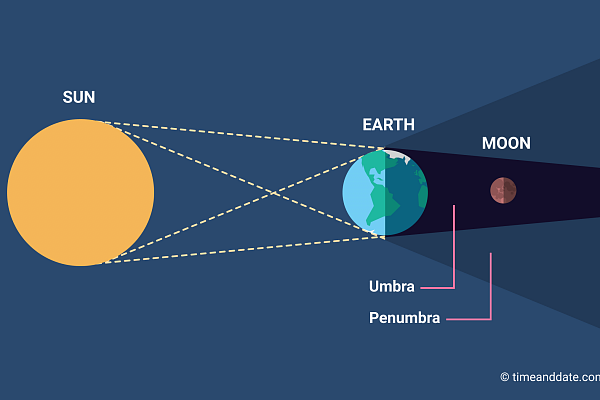
And the sun and moon being “brought together” could be an analogy for a solar eclipse. But it is the moon’s shadow that eclipses the sun as in the illustration below.
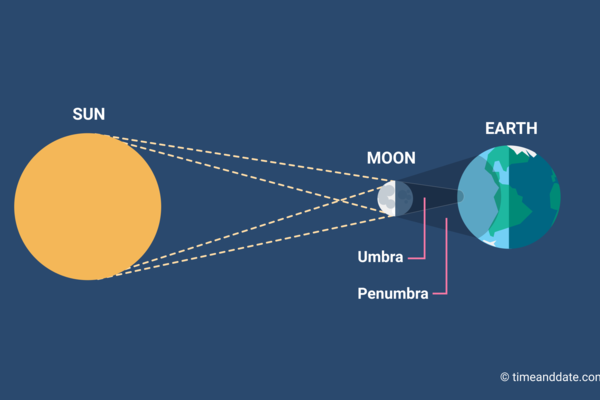
These two different eclipses can’t happen at the same time, as you can see above. And if the sun and moon were “merged” or brought together in any way whatsoever during a lunar eclipse, the whole system of gravity would have gone awry.
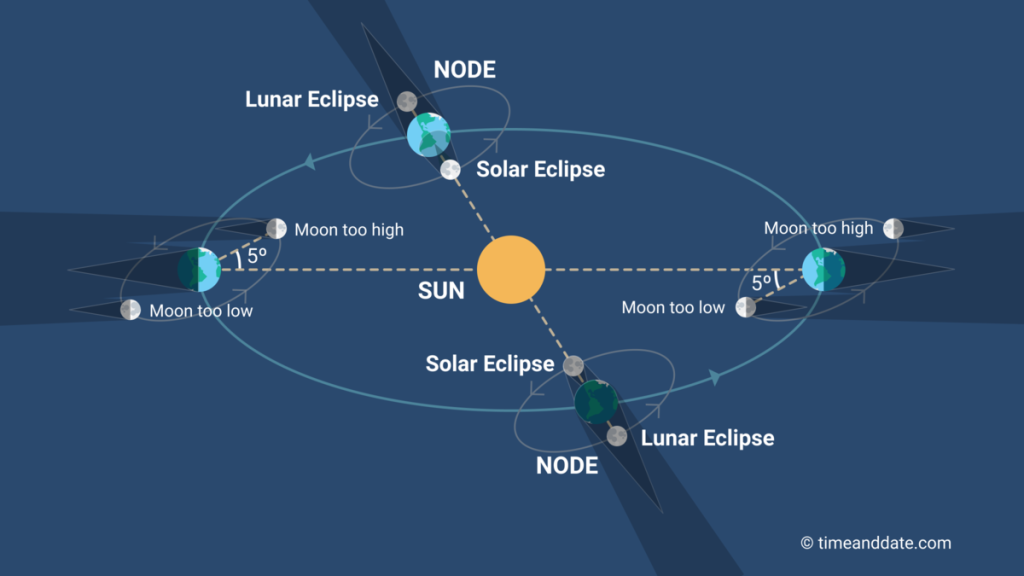
As the picture above shows, the lunar and solar eclipses are on exact opposite sides of the sun. That’s why it’s utterly impossible for the two to occur at the same time. Technically, there can be a solar eclipse about 15 days after a lunar eclipse, but not in the same place on earth and not seen by those who saw the lunar eclipse. And these ayat being adjacent doesn’t necessarily mean they describe simultaneous events, we draw our attention to the fact that this event immediately follows the question people asked of prophet Mohammad “when is the Day of Resurrection?” This is then Allah’s reply.
There are three elements here: our sight – 75:7 states “Then when the eyes are dazzled.” The word for dazzled is actually the verb form of the word for lightning and the word translated “eyes” is not “eyes” ‘ayūn, but “vision” al-basar. So what is described here is one’s vision being as if struck by a bolt of lightning. Then the moon was darkened/eclipsed as if swallowed by something. Then the sun and moon merge together as one.
In our era, it implies the two astronomical objects we know, the sun being our star and the moon a large satellite orbiting earth, were physically joined together.
At the time the Quran was sent, the Arabs knew more about the positions and movements of stars and planets than most modern non-scientists do, having named many of the stars themselves. They called the Andromeda galaxy “little cloud,” noticing it was unlike a star or planet, and with the darkness plus horizon of the desert, they surely were familiar with lunar eclipses as well as lunar cycles, and possibly at least heard of solar eclipses. Whether or not that was the case, they knew that any merging or bringing together of the moon and sun meant the whole system had gone awry. It wasn’t a darkening of the sun, it was the two becoming one, a terrifying image.
Of course, this sura is entitled Al-Qiyama, meaning the Day of Resurrection. These events are clearly describing that Day. And no scholar of the Quran to this day thinks this refers to an eclipse, but I bring it up to highlight the relationship between the moon/sun alignments and Resurrection/ Judgment Day, that eclipses are signs of that Day, just as the aya+word “that” in 6:58:5 matched the number of days for a Saros, 6585, where “that” referred to Resurrection/ Judgment Day.
Just as the Metonic cycle, in a different way, represents our “meeting” and return to Allah at an appointed time only He knows, so the eclipses, both solar and lunar, represent signs/miracles from the Almighty, All-Merciful to bring us certainty that only He has control over all things and is worthy of worship, and to Him alone will we return, with nothing but our deeds and hearts, what we intended and believed, and how we acted to help others or harm them just to attain “cheap” worldly goals like wealth and power – which have value in this world, but are utterly worthless in the Hereafter.
